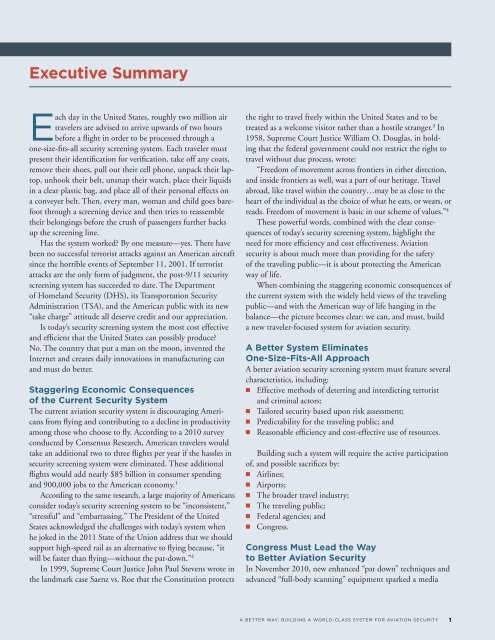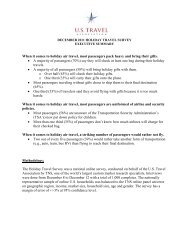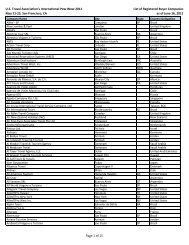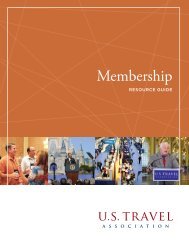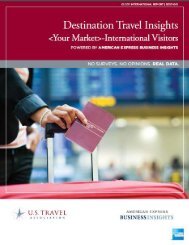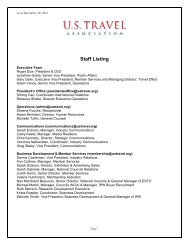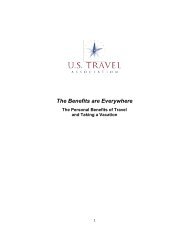Building a World-Class system for aviation seCurity - US Travel ...
Building a World-Class system for aviation seCurity - US Travel ...
Building a World-Class system for aviation seCurity - US Travel ...
You also want an ePaper? Increase the reach of your titles
YUMPU automatically turns print PDFs into web optimized ePapers that Google loves.
Executive SummaryEach day in the United States, roughly two million airtravelers are advised to arrive upwards of two hoursbe<strong>for</strong>e a flight in order to be processed through aone-size-fits-all security screening <strong>system</strong>. Each traveler mustpresent their identification <strong>for</strong> verification, take off any coats,remove their shoes, pull out their cell phone, unpack their laptop,unhook their belt, unsnap their watch, place their liquidsin a clear plastic bag, and place all of their personal effects ona conveyer belt. Then, every man, woman and child goes barefootthrough a screening device and then tries to reassembletheir belongings be<strong>for</strong>e the crush of passengers further backsup the screening line.Has the <strong>system</strong> worked? By one measure—yes. There havebeen no successful terrorist attacks against an American aircraftsince the horrible events of September 11, 2001. If terroristattacks are the only <strong>for</strong>m of judgment, the post-9/11 securityscreening <strong>system</strong> has succeeded to date. The Departmentof Homeland Security (DHS), its Transportation SecurityAdministration (TSA), and the American public with its new“take charge” attitude all deserve credit and our appreciation.Is today’s security screening <strong>system</strong> the most cost effectiveand efficient that the United States can possibly produce?No. The country that put a man on the moon, invented theInternet and creates daily innovations in manufacturing canand must do better.Staggering Economic Consequencesof the Current Security SystemThe current <strong>aviation</strong> security <strong>system</strong> is discouraging Americansfrom flying and contributing to a decline in productivityamong those who choose to fly. According to a 2010 surveyconducted by Consensus Research, American travelers wouldtake an additional two to three flights per year if the hassles insecurity screening <strong>system</strong> were eliminated. These additionalflights would add nearly $85 billion in consumer spendingand 900,000 jobs to the American economy. 1According to the same research, a large majority of Americansconsider today’s security screening <strong>system</strong> to be “inconsistent,”“stressful” and “embarrassing.” The President of the UnitedStates acknowledged the challenges with today’s <strong>system</strong> whenhe joked in the 2011 State of the Union address that we shouldsupport high-speed rail as an alternative to flying because, “itwill be faster than flying—without the pat-down.” 2In 1999, Supreme Court Justice John Paul Stevens wrote inthe landmark case Saenz vs. Roe that the Constitution protectsthe right to travel freely within the United States and to betreated as a welcome visitor rather than a hostile stranger. 3 In1958, Supreme Court Justice William O. Douglas, in holdingthat the federal government could not restrict the right totravel without due process, wrote:“Freedom of movement across frontiers in either direction,and inside frontiers as well, was a part of our heritage. <strong>Travel</strong>abroad, like travel within the country…may be as close to theheart of the individual as the choice of what he eats, or wears, orreads. Freedom of movement is basic in our scheme of values.” 4These powerful words, combined with the clear consequencesof today’s security screening <strong>system</strong>, highlight theneed <strong>for</strong> more efficiency and cost effectiveness. Aviationsecurity is about much more than providing <strong>for</strong> the safetyof the traveling public—it is about protecting the Americanway of life.When combining the staggering economic consequences ofthe current <strong>system</strong> with the widely held views of the travelingpublic—and with the American way of life hanging in thebalance—the picture becomes clear: we can, and must, builda new traveler-focused <strong>system</strong> <strong>for</strong> <strong>aviation</strong> security.A Better System EliminatesOne-Size-Fits-All ApproachA better <strong>aviation</strong> security screening <strong>system</strong> must feature severalcharacteristics, including:■■ Effective methods of deterring and interdicting terroristand criminal actors;■■ Tailored security based upon risk assessment;■■ Predictability <strong>for</strong> the traveling public; and■■ Reasonable efficiency and cost-effective use of resources.<strong>Building</strong> such a <strong>system</strong> will require the active participationof, and possible sacrifices by:■■ Airlines;■■ Airports;■■ The broader travel industry;■■ The traveling public;■■ Federal agencies; and■■ Congress.Congress Must Lead the Wayto Better Aviation SecurityIn November 2010, new enhanced “pat down” techniques andadvanced “full-body scanning” equipment sparked a mediaA Better Way: <strong>Building</strong> a <strong>World</strong>-<strong>Class</strong> System <strong>for</strong> Aviation Security 1


